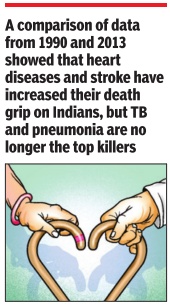Life Expectancy: India
This is a collection of articles archived for the excellence of their content. |
19 90–2013: 8.6 years added
December 18, 2014
One of the Best gains worldwide: The Lancet
Every fifth death in the world is that of an Indian, but Indians are also living at least 8.6 years longer on an average than in 1990, one of the best gains worldwide in life expectancy. In 2013, heart, lung or brain problems caused a third of all mortality in the country. Suicides, road traffic accidents and lifestyle disease diabetes have now muscled into the top 10 killers' list. Tuberculosis and heart diseases are the largest killers of Indians in the most productive age group of 15 to 49 years, says the first country-specific cause-of-death data for 188 countries published in The Lancet on
A comparison of the data from 1990 and 2013 showed that heart diseases and stroke have increased their death grip on Indians, but TB and pneumonia are no longer the top killers. “It is good news for India that the death share (26%) of the three major infectious diseases --tuberculosis (9%), pneumonia (9%) and diarrhoea (8%) -has reduced by 50% during the last 23 years,“ said Kaushalendra Kumar, one of the co-authors from the International Institute for Population Sciences in Deonar.
Another co-author Dr Nobhojit Roy , professor at BARC Hospital in Chembur, concurred. “India is going through an epidemiological transition with communicable diseases going down and non-communicable diseases going up. Diseases like malaria and HIV are down and lifestyle-related diseases such as heart diseases and hypertension are going up. The biggest indicator of India's relative better health is the rise in life expectancy.“Life expectancy improved for both men (64.2 years) and women (68.5 years) in India, at an average of 8.6 years gained since 1990. This was a larger increase than the global aver age, and one of the top 25 biggest gains in life expectancy worldwide, said the report.
The global report, coordinated by the Institute for Health Metrics and Evaluation (IHME) and funded by the Bill & Melinda Gates Foundation, said people live longer worldwide than they did two decades ago as death rates from infectious diseases and cardiovascular disease have fallen.
Since 1990, India saw marked declines in mortality from a number of diseases that used to take a large toll on the country . For instance, by 2013, mortality from diarrhoeal diseases reduced by 42%. In 1990, pneumonia and diarrhoeal diseases killed 15,32,459 people.Twenty-three years later, they claimed 7,15,303 fewer lives.
India, however, came in for a bit of criticism for poor health records while neighbouring China won praise for providing detailed reports.“India has to spend on research and surveillance. If you don't know what is killing people, how will you plan a health programme to check it?“ asked Dr Roy .
“All our policies and programmes are based on virtually no data and, therefore, it is difficult to measure effects of policy interventions or initiate effective programmes,“ said Kumar.
